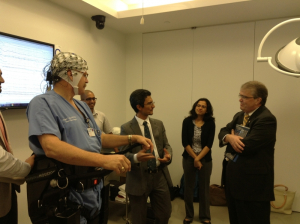Professor Jose Luis Contreras-Vidal, professor of electrical and computer engineering and biomedical engineering at the UH Cullen College of Engineering, demonstrated to U.S. Representative John Culberson how his brain-controlled exoskeleton helps paraplegic patients regain their mobility and independence simply through the power of their thoughts.
On August 22, Contreras-Vidal was invited to an event at The Methodist Hospital Research Institute to demonstrate his world-famous Rehab Rex exoskeleton to Rep. Culberson in action. Dr. Gene Alford, a paraplegic patient, used his brain waves to control the movement of the exoskeleton. Contreras-Vidal stood by Alford's side and explained how the technology worked as the once-wheelchair-bound doctor glided across the floor on his state-of-the-art robotic legs.
For years, said Contreras-Vidal, most researchers believed decoding movement intentions in the brain would require invasive technologies, such as electrodes implanted in the skull, “but we have been going against dogma for a long time.” Contreras-Vidal’s earlier research demonstrated that movement intentions related to the legs (such as walk, turn, and sit down) can be decoded with high accuracy through the scalp electroencephalogram (or EEG), which records the brain’s electrical activity through a skullcap fitted with electrodes that simply contact the scalp. Amazingly, what allows Dr. Alford to walk effortlessly across the floor is little more than what looks like a swim cap fitted to his head, spotted with colorful dots (the EEGs).
The event took place on August 22nd at The Methodist Hospital Research Institute, Texas Medical Center in Houston. The NeuroRex project is a joint collaboration with Dr. Robert Grossman.
